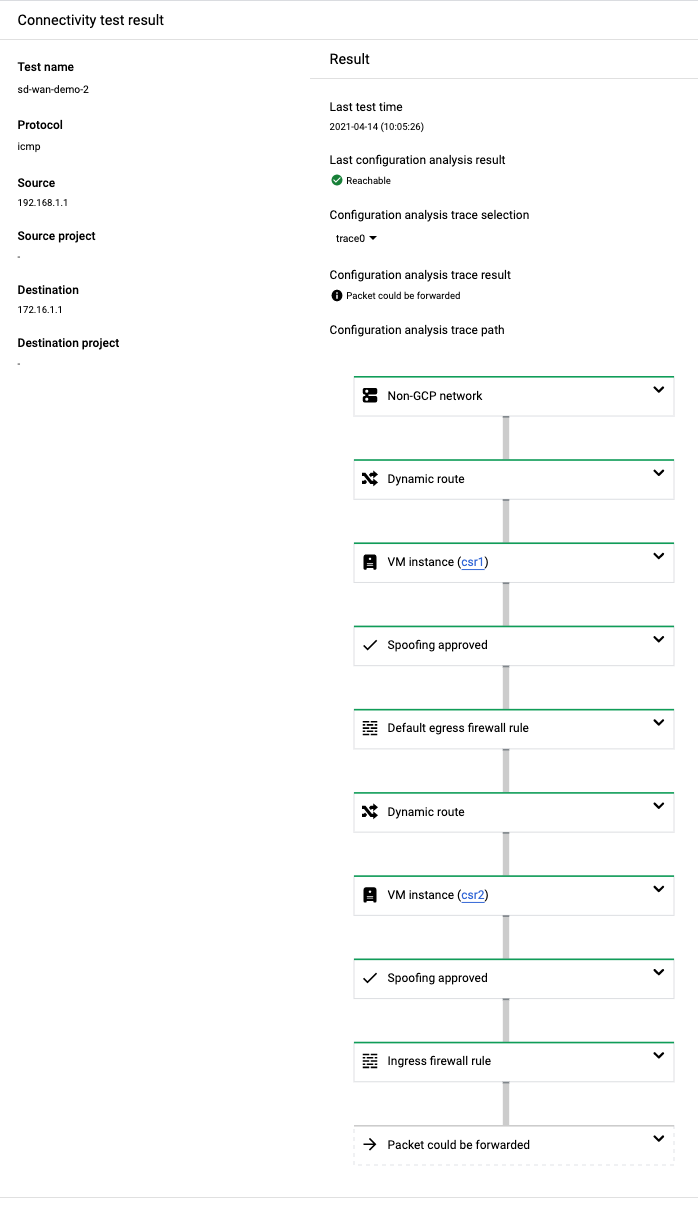This page describes the following common use cases for Connectivity Tests:
- Test connectivity from a Virtual Private Cloud (VPC) network to a non-Google Cloud network
- Test connectivity from a non-Google Cloud network to a VPC network
- Test connectivity between two non-Google Cloud networks
From a VPC network to a non-Google Cloud network
You can use the Connectivity Tests configuration analysis to test connectivity from your VPC network to a non-Google Cloud network over Cloud VPN or Cloud Interconnect. Typically, a non-Google Cloud network is your on-premises network or another cloud provider's network.
The configuration analysis evaluates the network path only up to the external IP address of the router or VPN gateway in a peer network.
The following example shows a trace from VM1 in a VPC network,
over a Classic VPN tunnel using static routing, to VM2 in an
on-premises network.

If there is a matching static or dynamic route for the destination IP address in a peer network, the configuration analysis matches and verifies the route according to route precedence.
There is a default static route for all destinations with the next hop as the internet gateway. Connectivity Tests can match this default route unless you have removed or modified it.
If the default static route does not exist and there are no other valid routes
to the destination, the trace returns a
final state of Drop.


From a non-Google Cloud network to a VPC network
The configuration analysis verifies that your VPC network can
receive an inbound packet from your on-premises network after that packet could
arrive at your VPC network. The analysis also verifies that the
VPC network configuration is likely to allow delivery of this
packet to the intended destination. The configuration analysis shows that
Packet could be delivered (in the API response, a final
state of delivered). The
destination is considered reachable.
When your VPC network peers with your on-premises network through Cloud Router, the VPC network receives one or more dynamic routes from your peered on-premises network. At the same time, your VPC network advertises its own routes to your peered on-premises network.
Because Connectivity Tests doesn't have access to your on-premises network configuration, it can't verify the configuration of correct routes and firewall rules on your on-premises router. Thus, traffic from your on-premises network to your VPC network is always considered valid by the Connectivity Tests configuration analysis.
However, Connectivity Tests can evaluate whether the VPC configuration allows delivery of a packet to a destination in Google Cloud. To assess reachability, it evaluates the following Google Cloud resources:
- The VPC network's ingress firewall rules.
- The advertised route for IP addresses in your VPC network that Cloud Router advertises to your on-premises (peer) network.
In general, when you want to specify an on-premises IP address for either a source or destination endpoint, clear the checkbox labeled This is an IP address used in Google Cloud. To set up a test like the one shown in this example, clear the checkbox for the source endpoint.
The following successful test result evaluates connectivity through Cloud VPN from the on-premises IP address to a VM instance. It also evaluates the Border Gateway Protocol (BGP) session, routes, and VPC firewall rules.

Between two non-Google Cloud networks
You can use the Connectivity Tests configuration analysis to evaluate reachability between two non-Google Cloud networks that are connected through Network Connectivity Center. In this context, a non-Google Cloud network is typically your on-premises data center or a branch office.
Because Connectivity Tests doesn't have access to your on-premises network configuration, it can't verify the configuration of routes and firewall rules on your on-premises router. Thus, traffic from your on-premises network to your VPC network is always considered valid by the Connectivity Tests configuration analysis, and only configurations within Google Cloud are verified.
The configuration analysis learns the on-premises network ranges from the Cloud Routers associated with the Network Connectivity Center spokes. You can identify configuration issues within your VPC network that can impact connectivity between the on-premises networks.
All Network Connectivity Center spoke types use Cloud Routers to exchange routes through BGP sessions. For example:
- Router appliance spokes: When Cloud Router and router appliance instances are in the same region, they exchange routes with one another.
- Cloud VPN and VLAN attachment spokes: Cloud Routers exchange BGP routes with routers in the on-premises network.
For more information about Network Connectivity Center, see the Network Connectivity Center overview.
Between two non-Google Cloud networks through Router appliance
In the following example, Connectivity Tests traces a simulated packet from one on-premises network to another. The packet enters the VPC network from the Router appliance spoke connected to the first on-premises network. From there, it follows a dynamic route as advertised by the Cloud Router associated with the Router appliance spoke that is connected to the second on-premises network. The packet reaches the on-premises network from the second router appliance instance.
To set up a test of this type, make sure that, for both the source and destination endpoint, you clear the checkbox labeled This is an IP address used in Google Cloud.
The following successful test result evaluates connectivity from an on-premises network through two router appliance instances to another on-premises network. It also evaluates the BGP session, routes, and VPC firewall rules.

Between two non-Google Cloud networks through Cloud VPN and Cloud Interconnect
In the following example, Connectivity Tests traces a simulated packet from one on-premises network to another. The packet enters the VPC network through the VPN gateway. The packet reaches the other on-premises network through an Interconnect connection.
To set up a test of this type, make sure that, for both the source and destination endpoint, you clear the checkbox labeled This is an IP address used in Google Cloud.
The following successful test result evaluates connectivity from an on-premises network through VPN and VLAN attachment spokes to another on-premises network.




